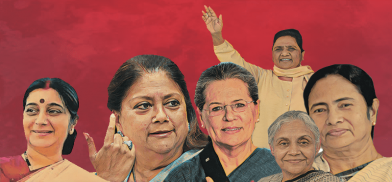Women in Indian politics: Need for foundational changes to address gender disparity
In the recent 2024 Lok Sabha elections, only 797 women filed nominations, out of a total of 8,360 candidates, and only 74 women were elected (Lok Sabha Elections 2024, Association of Democratic Reforms). From 2019 to 2024, the share of female candidates increased by only 0.5%, and their winning share remained below average, regressing to 13% of total MPs, a decrease that contrasts starkly with the legislated reservation of 33% of seats for women

Gender parity in politics is essential for achieving a balanced and representative governance system. The Global Gender Gap Index 2023, published by the World Economic Forum, found that on the political empowerment parameter, India registered only 25.3 percent parity. With a female population of 652 million, this level of representation is not sufficient. Although women contest elections, men are more likely to be elected.
The 2024 Lok Sabha elections illustrate this disparity: the 18th Lok Sabha comprises only 74 women as compared to 469 men. Several intersectoral barriers hinder women's participation in politics, and addressing them is essential to facilitate their unrestrained involvement in political processes and elections.
Struggle for empowerment
Studying the history of women-centric policies and reservations reveal the challenges faced in passing such measures at the legislative level. Despite the significant participation of women in the Indian national movement, and the Constitution of India granting universal adult franchise, women still occupy less than 15 percent of the political space (IPU Parline, June 2024).
The issue of women’s reservation had gained momentum in the 1970s, when the Committee on the Status of Women in India (CSWI) noted that India had failed in its constitutional responsibility to ensure gender equality and brought the issue of reservation of seats for women (Towards Equality, Government of India, 1974). Although voter participation amongst women was increasing, their representation as candidates was declining.
In 1988, Rajiv Gandhi’s government introduced the National Perspective Plan for Women, which included the reservation of 30 percent of seats for women in elected bodies. Subsequently, in 1992, the 73rd and 74th Constitutional Amendment Acts were enacted, mandating the reservation of one-third of seats for women in Panchayati Raj institutions (PRIs) and municipal bodies. This amendment was made in order to improve the position of women at the grassroot levels (Chadha 2014).
The entry of nearly one million women in PRIs motivated demands for similar reservations in parliament and state assemblies by 1996 (Sharma 1998). On September 12, 1996, the Women's Reservation Bill was introduced in the Parliament, as the 81st Constitution Amendment Bill. However, the bill lapsed due to lack of political consensus on its ability to bring 'social justice' for women (Sharma 1998). Following the dissolution of the 11th Lok Sabha, the Bill was referred to a Joint Parliamentary Committee chaired by Geeta Mukherjee of the Communist Party of India (CPI). It recommended reservations in the Rajya Sabha and the Legislative Councils, urging the Parliament of India to pass the Bill promptly.
The Bill faced repeated failures between 1998 and 2003, starkly contrasting with the broad support for the 73rd and 74th Constitutional Amendments, which were celebrated as a 'historic step' toward democratic decentralisation. This division has been attributed to a ‘collective male parliamentarian cold feet’, where the fear of opposing a move towards 'women's political empowerment' was regarded as politically incorrect, while supporting the Bill was seen as suicidal (Sharma 1998).
Under the United Progressive Alliance (UPA) government, the Women’s Reservation Bill was included in the Common Minimum Programme (CPM). It made significant progress by passing in the Rajya Sabha in 2010, reserving one-third of all seats for women in Lok Sabha and the State Legislative Assemblies. However, the Bill lapsed after dissent from political fractions due to its lack of representation of women from Other Backward Classes, and the subsequent dissolution of the 15th Lok Sabha, stalling further progress.
In 2013, the Ministry of Women and Child Development constituted a high-level committee on the Status of Women in India (HLCSW), which submitted its report in 2015. The Report on the Status of Women in India highlighted the dismal representation of women in state assemblies and parliament and recommended reserving at least 50 percent seats for women in local bodies, state legislative assemblies, Parliament, ministerial levels, and all decision-making bodies of the government.
The long pending issue of the women’s parliamentary reservation was re-introduced for the seventh time in the Lok Sabha on September 19, 2023. The Constitution (One Hundred and Twenty-Eighth Amendment) Bill, 2023 or the Women's Reservation Bill 2023 was passed in the Lok Sabha with 454 votes and in the Rajya Sabha with 214 votes. President Draupadi Murmu signed the bill on September 29, 2023, and it will be implemented following delimitation in 2026.
Women’s Reservation Bill
The Bill introduces Article 332A which reserves one-third of all seats for women in the Lok Sabha, State Legislative Assemblies, and the Legislative Assembly of the National Capital Territory (NCT) of Delhi. With reservations for women, there is a higher chance of women-specific issues to be better represented in the political arena as it promotes equitable resource distribution (Pande 2003). Opponents of the reservation policy argue that it would perpetuate the unequal status of women since they would not be perceived to be competing on merit and will divert attention from pressing issues such as criminalisation of politics, internal democracy in political parties, influence of black money, etc. (PRS Legislative Research, 2023).
The Bill introduces Article 334A, according to which, reservations will be implemented after the Census of India is conducted. Based on the Census, delimitation will be done to reserve seats for women, which will be applicable for fifteen years from the day of implementation. Following each delimitation, the reserved seats will be rotated. However, the dates for both of these exercises are pending, therefore, the implementation of reservation will also be delayed. This ‘delayed empowerment’ leads to questioning of the effectiveness of the Bill. Rotation of reserved seats may also reduce the incentive for MPs to work for their constituencies as they could be ineligible to seek re-election from that constituency (Nanivadekar 2003).
The Bill is criticised for giving quota within quota in the Lok Sabha and Vidhan Sabhas. One-third of the seats reserved for Scheduled Tribes and Scheduled Castes will be reserved for women from these categories, therefore, no separate reserved seats have been provided. The Bill, however, does not include reservations for women from Other Backward Classes (OBCs). Similarly, in the general category, 137 out of 275 seats can be contested for by all women, irrespective of their caste. However, such competition is likely to favour women from privileged backgrounds more due to access to resources and social networks, and become another form of elite control (Menon 2000).
Women in 2024 elections
In the recent 2024 Lok Sabha elections, only 797 women filed nominations out of a total of 8,360 candidates, and only 74 women were elected (Lok Sabha Elections 2024, Association of Democratic Reforms). From 2019 to 2024, the share of female candidates increased by only 0.5%, and their winning share remained below average, regressing to 13% of total MPs, a decrease that contrasts starkly with the legislated reservation of 33% of seats for women. Key obstacles for women include limited party support, financial assistance, and political networks, coupled with stringent standards (Sharma 2019). It is important to recognize that even filing for nomination by a woman is a significant step, as politics is traditionally viewed as a male-dominated field.
Women voter’s turnout has increased exponentially since the first general election. In the article, ‘From 1951-2019: How women voters outnumbered men in Lok Sabha polls’, Adrija Roychowdhury outlined that over the years, the gap between male and female voter turnout ranged from 11 to 17 percent.
However, starting from the 1991 election, this gap has steadily narrowed. By the 16th Lok Sabha election in 2014, the difference in turnout had decreased to 1.4 percent, and in the 2019 election, women voters surpassed men by a margin of 1.7 percent. The rise in female voter turnout over the past decade can be linked to increased awareness of voting rights, a surge in the registration of women voters, and the 50 percent reservation in local body elections, which made women more conscious of the need to do their democratic duty.
Another reason is grassroots mobilization and the welfare schemes centered around women (‘How Women Voted’, Frontline, 2024). On the other hand, the National Election Study (NES) conducted by the Lokniti Programme of the Centre for the Study of Developing Societies noted that women lagged behind in other forms of political engagement such as participation in campaign activities or attending public meetings.
Institutional reforms and social transformation
Women's political engagement in India is obstructed by a number of factors, including socio-economic status, geographical, cultural, and political systems (Shvedova 2007). Illiteracy, poverty, caste discrimination, and lack of property ownership disempower women and exclude them from the political process, perpetuating cycles of marginalisation. Addressing these challenges necessitates coordinated efforts from the government, political parties, civil society, and the public. Institutional reforms and social transformation—education, financial independence, and media awareness—can enhance women’s political participation. There should be a well-developed education system to guide women in the field of politics, to help them navigate the electoral system, which has historically favoured men. Women's platforms need to be bolstered, and training and orientation programs should be provided to emerging and elected women leaders to enhance their leadership skills.
Thus, to fully address the issue, it is essential to adopt an intersectoral perspective. Political speeches, campaign manifestos, and gendered policies will remain symbolic unless these foundational issues are addressed first.
(The author is a postgraduate student at the Department of Policy and Management Studies, TERI School Of Advanced Studies (TERI SAS), New Delhi, India. Views expressed are personal. She can be reached at shreyaborah17@gmail.com. )
References:
Agnihotri, Indu (2023): “The Women of the Women’s Reservation Bill,” The Wire.
Alam, Shah. (2015): “Participation of women in Indian politics and the role of media,” International Journal of Advanced Research in Management and Social Sciences.
Chadha, Anuradha (2014): “Political Participation of Women: A Case Study in India,” OIDA International Journal of Sustainable Development.
Ghosh, Ambar (2023): “Women’s Representation in India’s Parliament: Measuring Progress, Analysing Obstacles,” Observer Research Foundation.
World Economic Forum (2023): Global Gender Gap Report 2023.
PRS Legislative Research (2023): Issues for Consideration: The Constitution (128th Amendment) Bill, 2023 (Women’s Reservation Bill).
Khullar, Akansha (2024): “Women in Indian Politics: A story that has changed little over the years,” Firstpost.
Menon, Nivedita (2000): “Elusive 'Woman': Feminism and Women's Reservation Bill,” Economic and Political Weekly.
IPU Parline (June, 2024): Monthly Ranking of Women in National Parliaments.
Nanivadekar, Medha (2003), “Dual-Member Constituencies: Resolving Deadlock on Women’s Reservation,” Economic and Political Weekly.
Pande, Rohini (2003): “Can Mandated Political Representation Increase Policy Influence for Disadvantaged Minorities? Theory and Evidence from India,” The American Economic Review, Vol. 93, No. 4.
Rajalakshmi, T.R (2024): “How Women Voted,” Frontline.
Roychowdhury, Adrija (2024): “From 1951-2019: How women voters outnumbered men in Lok Sabha polls,” The Indian Express.
Sharma, Aradhana (2019): “Challenges faced by women leadership in politics,” International Journal of Political Science and Governance 2019, 1(1): 60-62.
Sharma, Kalpana (2024): “General Elections 2024 | The missing women in Indian politics,” The Hindu.
Sharma, Kumud (1998): “Power vs. Representation: Feminist Dilemmas, Ambivalent State and the Debate on Reservation for Women in India,” Centre for Women’s Development Studies.
Shvedova, Nadezda (2007): “Obstacles to women’s participation in Parliament,” In Women in parliament: Beyond numbers.
Singh, Sanaya (2011): “Challenges faced by women for vertical mobility in politics: A comparative study of Sweden and India, A structural social work approach for gender empowerment,” University of Gävle, Faculty of Health and Occupational Studies, Department of Social Work and Psychology.
The Office of the High Commissioner for Human Rights. (2023). India –Passing of Women’s Reservation Bill.
Committee on the Status of Women in India, Ministry of Women and Child Development (1974): “Towards Equality,” Govt. of India, New Delhi.
PRS Legislative Research (2023): Women's Reservation Bill [The Constitution (108th Amendment) Bill, 2008].
Women Sarpanch, but husband wears the pants (2023): The Times of India.
When Will the Women's Reservation Bill Be Implemented? – Explained (2023): Outlook.










Post a Comment